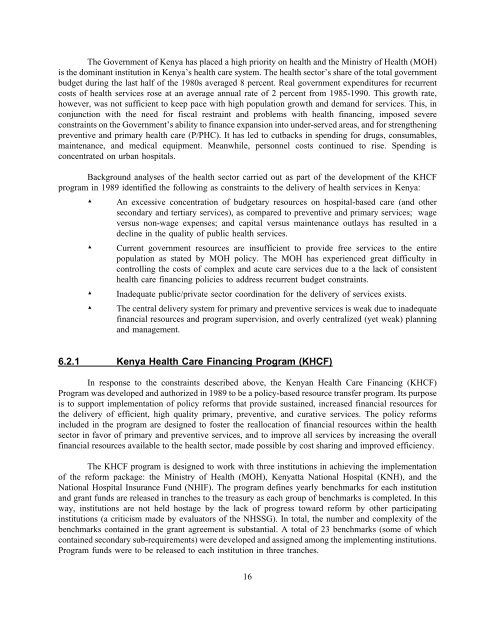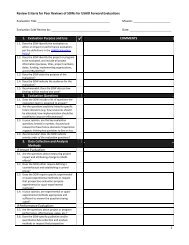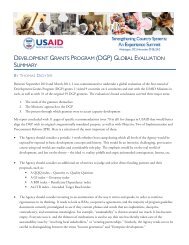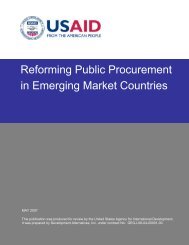Study on USAID Non-Project Assistance Programs in
Study on USAID Non-Project Assistance Programs in
Study on USAID Non-Project Assistance Programs in
You also want an ePaper? Increase the reach of your titles
YUMPU automatically turns print PDFs into web optimized ePapers that Google loves.
The Government of Kenya has placed a high priority <strong>on</strong> health and the M<strong>in</strong>istry of Health (MOH)is the dom<strong>in</strong>ant <strong>in</strong>stituti<strong>on</strong> <strong>in</strong> Kenya’s health care system. The health sector’s share of the total governmentbudget dur<strong>in</strong>g the last half of the 1980s averaged 8 percent. Real government expenditures for recurrentcosts of health services rose at an average annual rate of 2 percent from 1985-1990. This growth rate,however, was not sufficient to keep pace with high populati<strong>on</strong> growth and demand for services. This, <strong>in</strong>c<strong>on</strong>juncti<strong>on</strong> with the need for fiscal restra<strong>in</strong>t and problems with health f<strong>in</strong>anc<strong>in</strong>g, imposed severec<strong>on</strong>stra<strong>in</strong>ts <strong>on</strong> the Government’s ability to f<strong>in</strong>ance expansi<strong>on</strong> <strong>in</strong>to under-served areas, and for strengthen<strong>in</strong>gpreventive and primary health care (P/PHC). It has led to cutbacks <strong>in</strong> spend<strong>in</strong>g for drugs, c<strong>on</strong>sumables,ma<strong>in</strong>tenance, and medical equipment. Meanwhile, pers<strong>on</strong>nel costs c<strong>on</strong>t<strong>in</strong>ued to rise. Spend<strong>in</strong>g isc<strong>on</strong>centrated <strong>on</strong> urban hospitals.Background analyses of the health sector carried out as part of the development of the KHCFprogram <strong>in</strong> 1989 identified the follow<strong>in</strong>g as c<strong>on</strong>stra<strong>in</strong>ts to the delivery of health services <strong>in</strong> Kenya:An excessive c<strong>on</strong>centrati<strong>on</strong> of budgetary resources <strong>on</strong> hospital-based care (and othersec<strong>on</strong>dary and tertiary services), as compared to preventive and primary services; wageversus n<strong>on</strong>-wage expenses; and capital versus ma<strong>in</strong>tenance outlays has resulted <strong>in</strong> adecl<strong>in</strong>e <strong>in</strong> the quality of public health services.Current government resources are <strong>in</strong>sufficient to provide free services to the entirepopulati<strong>on</strong> as stated by MOH policy. The MOH has experienced great difficulty <strong>in</strong>c<strong>on</strong>troll<strong>in</strong>g the costs of complex and acute care services due to a the lack of c<strong>on</strong>sistenthealth care f<strong>in</strong>anc<strong>in</strong>g policies to address recurrent budget c<strong>on</strong>stra<strong>in</strong>ts.Inadequate public/private sector coord<strong>in</strong>ati<strong>on</strong> for the delivery of services exists.The central delivery system for primary and preventive services is weak due to <strong>in</strong>adequatef<strong>in</strong>ancial resources and program supervisi<strong>on</strong>, and overly centralized (yet weak) plann<strong>in</strong>gand management.6.2.1 Kenya Health Care F<strong>in</strong>anc<strong>in</strong>g Program (KHCF)In resp<strong>on</strong>se to the c<strong>on</strong>stra<strong>in</strong>ts described above, the Kenyan Health Care F<strong>in</strong>anc<strong>in</strong>g (KHCF)Program was developed and authorized <strong>in</strong> 1989 to be a policy-based resource transfer program. Its purposeis to support implementati<strong>on</strong> of policy reforms that provide susta<strong>in</strong>ed, <strong>in</strong>creased f<strong>in</strong>ancial resources forthe delivery of efficient, high quality primary, preventive, and curative services. The policy reforms<strong>in</strong>cluded <strong>in</strong> the program are designed to foster the reallocati<strong>on</strong> of f<strong>in</strong>ancial resources with<strong>in</strong> the healthsector <strong>in</strong> favor of primary and preventive services, and to improve all services by <strong>in</strong>creas<strong>in</strong>g the overallf<strong>in</strong>ancial resources available to the health sector, made possible by cost shar<strong>in</strong>g and improved efficiency.The KHCF program is designed to work with three <strong>in</strong>stituti<strong>on</strong>s <strong>in</strong> achiev<strong>in</strong>g the implementati<strong>on</strong>of the reform package: the M<strong>in</strong>istry of Health (MOH), Kenyatta Nati<strong>on</strong>al Hospital (KNH), and theNati<strong>on</strong>al Hospital Insurance Fund (NHIF). The program def<strong>in</strong>es yearly benchmarks for each <strong>in</strong>stituti<strong>on</strong>and grant funds are released <strong>in</strong> tranches to the treasury as each group of benchmarks is completed. In thisway, <strong>in</strong>stituti<strong>on</strong>s are not held hostage by the lack of progress toward reform by other participat<strong>in</strong>g<strong>in</strong>stituti<strong>on</strong>s (a criticism made by evaluators of the NHSSG). In total, the number and complexity of thebenchmarks c<strong>on</strong>ta<strong>in</strong>ed <strong>in</strong> the grant agreement is substantial. A total of 23 benchmarks (some of whichc<strong>on</strong>ta<strong>in</strong>ed sec<strong>on</strong>dary sub-requirements) were developed and assigned am<strong>on</strong>g the implement<strong>in</strong>g <strong>in</strong>stituti<strong>on</strong>s.Program funds were to be released to each <strong>in</strong>stituti<strong>on</strong> <strong>in</strong> three tranches.16







